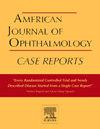Iris and anterior chamber angle melanoma masquerading as benign melanocytic lesion
Q3 Medicine
引用次数: 0
Abstract
Purpose
Demonstrates the importance of integrating clinical findings, immunohistochemistry, and next-generation sequencing of somatic mutations in differentiating complex ocular melanocytic lesions. This study highlights distinct differences between benign conjunctival nevus, iris melanoma with extrascleral extension, and conjunctival melanoma with intraocular invasion.
Observations
A 62-year-old male presented with painless vision loss and multiple pigmented lesions on the ocular surface. Initial impression was a benign conjunctival nevus but concerning for melanoma due to secondary changes of vision loss and increased intraocular pressure. Further investigation revealed an iris melanoma involving the anterior chamber angle with extrascleral extension. Enucleation confirmed atypical melanocytic cells infiltrating the iris stroma, anterior chamber angle, sclera, and conjunctiva. Immunohistochemistry showed SRY-Box Transcription Factor 10 (SOX10) and melanoma antigen (Melan-A) positivity. Gene sequencing identified a Guanine nucleotide-binding protein, alpha-11 (GNA11) mutation, suggesting uveal origin.
Conclusions and importance
Highlights the value of a comprehensive diagnostic approach in evaluating ocular melanocytic lesions. The progression from an initial impression of benign conjunctival nevus to the discovery of iris melanoma with extrascleral extension emphasizes the need for thorough investigation, especially when pathological changes such as increased intraocular pressure and vision loss occur.
虹膜和前房角黑色素瘤伪装成良性黑色素细胞病变
目的:证明综合临床表现、免疫组织化学和下一代体细胞突变测序在鉴别复杂的眼部黑素细胞病变中的重要性。本研究强调了良性结膜痣、巩膜外延伸的虹膜黑色素瘤和眼内侵犯的结膜黑色素瘤之间的明显差异。62岁男性,无痛性视力减退,眼表多发色素病变。最初的印象是良性结膜痣,但由于继发性视力丧失和眼压升高而担心黑色素瘤。进一步的调查显示虹膜黑色素瘤累及前房角及巩膜外延伸。去核证实非典型黑素细胞浸润虹膜间质、前房角、巩膜和结膜。免疫组化显示SRY-Box转录因子10 (SOX10)和黑色素瘤抗原(Melan-A)阳性。基因测序鉴定出鸟嘌呤核苷酸结合蛋白α -11 (GNA11)突变,提示葡萄膜起源。结论和重要性强调综合诊断方法在评估眼部黑色素细胞病变中的价值。从最初的良性结膜痣到发现具有巩膜外延伸的虹膜黑色素瘤的进展强调了彻底调查的必要性,特别是当出现眼压升高和视力丧失等病理变化时。
本文章由计算机程序翻译,如有差异,请以英文原文为准。
求助全文
约1分钟内获得全文
求助全文
来源期刊

American Journal of Ophthalmology Case Reports
Medicine-Ophthalmology
CiteScore
2.40
自引率
0.00%
发文量
513
审稿时长
16 weeks
期刊介绍:
The American Journal of Ophthalmology Case Reports is a peer-reviewed, scientific publication that welcomes the submission of original, previously unpublished case report manuscripts directed to ophthalmologists and visual science specialists. The cases shall be challenging and stimulating but shall also be presented in an educational format to engage the readers as if they are working alongside with the caring clinician scientists to manage the patients. Submissions shall be clear, concise, and well-documented reports. Brief reports and case series submissions on specific themes are also very welcome.
 求助内容:
求助内容: 应助结果提醒方式:
应助结果提醒方式:


